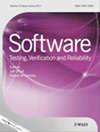Integrating pattern matching and abstract interpretation for verifying cautions of microcontrollers
IF 1.2
4区 计算机科学
Q3 COMPUTER SCIENCE, SOFTWARE ENGINEERING
引用次数: 1
Abstract
Handling hardware‐dependent properties at a low level is usually required in developing microcontroller‐based applications. One of these hardware‐dependent properties is cautions, which are described in microcontrollers hardware manuals. The process of verifying these cautions is performed manually, as there is currently no single tool that can directly handle this task. This research aims at automating the verification of these cautions. To obtain the typical cautions of microcontrollers, we investigate two sections which have a considerable number of required cautions in the hardware manual of a popular microcontroller. Subsequently, we analyse these cautions and categorize them into several groups. Based on this analysis, we propose a semi‐automatic approach for verifying the cautions which integrates two static programme analysis techniques (i.e., pattern matching and abstract interpretation). To evaluate our approach, we conducted experiments with generated source code, benchmark source code, and industrial source code. The generated source code, which was created automatically based on several aspects of the C programme, was used to evaluate the performance of the approach based on these aspects. The benchmark and the industrial source code, which were provided by Aisin Software Co., Ltd., were used to assess the feasibility and applicability of the approach. The results show that all expected violations in the benchmark source code were detected. Unexpected but real violations in the benchmark programme were also detected. For the industrial source code, the approach successfully handled and detected most of the expected violations. These results show that the approach is promising in verifying the cautions.集成模式匹配和抽象解释,以验证微控制器的注意事项
在开发基于微控制器的应用程序时,通常需要在较低的水平上处理硬件相关的属性。这些与硬件相关的属性之一是注意事项,在微控制器硬件手册中有描述。验证这些注意事项的过程是手动执行的,因为目前没有单一的工具可以直接处理此任务。本研究旨在自动化验证这些警告。为了获得微控制器的典型注意事项,我们研究了在流行微控制器的硬件手册中具有相当数量所需注意事项的两个部分。随后,我们对这些警告进行了分析,并将其分为几类。基于这一分析,我们提出了一种半自动方法来验证警告,该方法集成了两种静态程序分析技术(即模式匹配和抽象解释)。为了评估我们的方法,我们对生成的源代码、基准源代码和工业源代码进行了实验。生成的源代码是基于C程序的几个方面自动创建的,用于评估基于这些方面的方法的性能。通过爱信软件有限公司提供的基准测试和工业源代码,对该方法的可行性和适用性进行了评估。结果表明,在基准测试源代码中检测到所有预期的违规。在基准程序中也发现了意外但真实的违规行为。对于工业源代码,该方法成功地处理和检测了大多数预期的违规。这些结果表明,该方法在验证这些警告方面是有希望的。
本文章由计算机程序翻译,如有差异,请以英文原文为准。
求助全文
约1分钟内获得全文
求助全文
来源期刊

Software Testing Verification & Reliability
工程技术-计算机:软件工程
CiteScore
3.70
自引率
0.00%
发文量
34
审稿时长
>12 weeks
期刊介绍:
The journal is the premier outlet for research results on the subjects of testing, verification and reliability. Readers will find useful research on issues pertaining to building better software and evaluating it.
The journal is unique in its emphasis on theoretical foundations and applications to real-world software development. The balance of theory, empirical work, and practical applications provide readers with better techniques for testing, verifying and improving the reliability of software.
The journal targets researchers, practitioners, educators and students that have a vested interest in results generated by high-quality testing, verification and reliability modeling and evaluation of software. Topics of special interest include, but are not limited to:
-New criteria for software testing and verification
-Application of existing software testing and verification techniques to new types of software, including web applications, web services, embedded software, aspect-oriented software, and software architectures
-Model based testing
-Formal verification techniques such as model-checking
-Comparison of testing and verification techniques
-Measurement of and metrics for testing, verification and reliability
-Industrial experience with cutting edge techniques
-Descriptions and evaluations of commercial and open-source software testing tools
-Reliability modeling, measurement and application
-Testing and verification of software security
-Automated test data generation
-Process issues and methods
-Non-functional testing
 求助内容:
求助内容: 应助结果提醒方式:
应助结果提醒方式:


